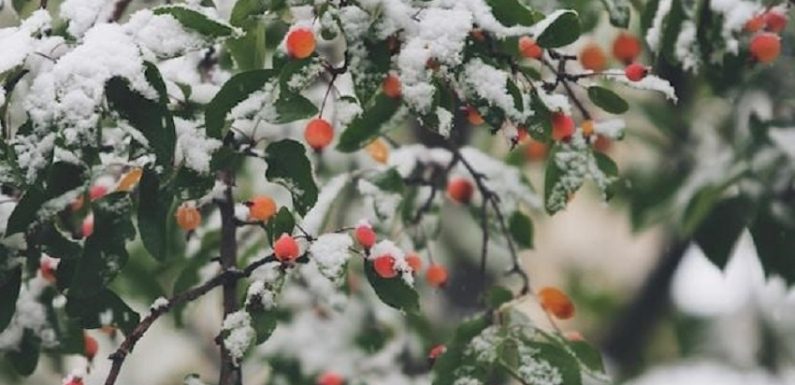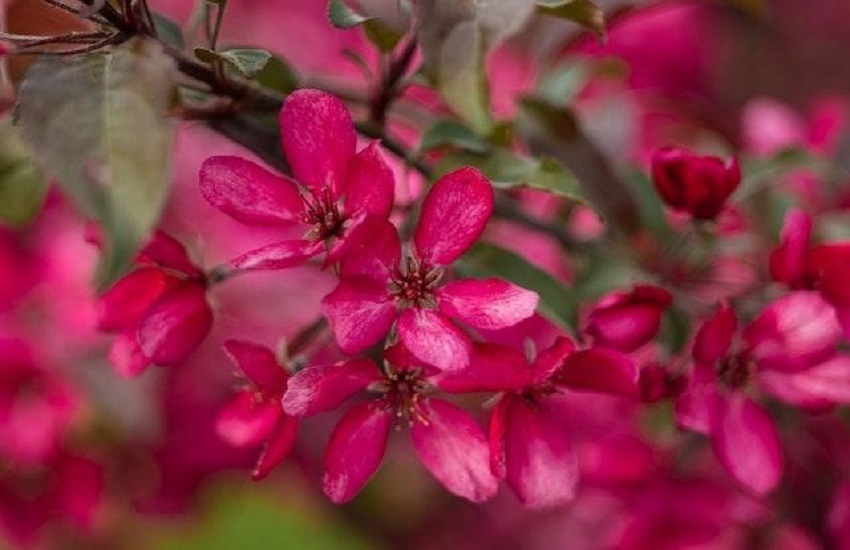
Visitors will find blooming crabapple trees in April and May throughout northern New Mexico regions. The trees flower in blooms of brilliant magenta to a vivid white with no particular preference in soil but a need for plenty of air circulation and exposure to the sun.
The tree can adapt to drought conditions and compact soil, allowing them to thrive in the climate typical of the Southwest.
Two variants are found in the Santa Fe Botanical Gardens, specifically the “Indian Magic” and the “Radiant.” “Prairifire” is a vibrant cultivar that does well in the region as well. Many of the diseases prominent among other crabapples don’t plague this variant.
It’s curious how a fruit tree came to live and thrive in an arid climate like that of New Mexico, but these were imported in the 1800s by American settlers. The tree has established itself and has grown strong within residential gardens and New Mexico orchards.
What are some pros and cons of a crabapple tree? Let’s learn more about this tree variety.
What Are The Pros And Cons Of The Crabapple Trees
While the crabapple tree is not native to New Mexico, the residents of northern New Mexico have enjoyed its splendor for centuries. The blooms strike every April into May in varying hues of vibrant pins and vivid whites.
The deciduous tree loses its leaves in the fall, only to be replaced by fruit in varied colors of purple, orange, gold, red, and yellow. These can be exceptionally beneficial to the birds in the winter. Let’s look at some of the other pros and cons associated with this particular tree.
● The brilliant foliage presents a radiant display year-round
In what can otherwise lack vibrancy in New Mexico’s arid climate, the crabapple tree presents a year-round display of beautiful colors against the desert backdrop. The blooms begin in April with the brightly colored flowers. The variants that grow in these regions are usually either brilliant magenta or pure white.
These transition to vivid colored leaves in the fall that then drop to display bright colored fruits in an array of orange, purple, red, yellow, and on. The fruit can remain throughout the winter until the flower returns in the spring.
With the flowers come pollinators, a necessity for any region, butterflies, and bees. And the fruit attracts a range of different birds who stick around for the food source.
● Some of the variants are now resistant to disease
Many crabapples from times past were prone to disease. Some variants today, especially those in the New Mexico region like the Prairifire, are resistant to diseases typical to the species. Diseases other species of fruit trees are more susceptible to, like fire blight or apple scab, are less threatening to this tree.
The resilience allows the crabapple to thrive in New Mexico with minimal maintenance as compared to other species that have also been imported but haven’t fared as well.
Please visit https://legacytreecompany.com/albuquerque-arborist for specific tree care guidelines.
This particular tree adapts to virtually any condition, soil, or circumstance with good results and has done so in New Mexico quite proudly. That’s been true since its arrival in the 1800s when it was imported. It might not be native, but it acts as though it is.
● The tree has varied sizes
Many people want to benefit from a tree but don’t have the space because they live in an apartment with only a balcony or their home has a tiny garden space. The crabapple allows for small spaces since the tree comes in varied sizes. This means anyone can enjoy the splendor of its showiness.
The sizes range from compact and dwarf to full size. That means you can plant one in a container and sit it on a patio, front porch, or driveway when your garden space is nonexistent. The tree will still exhibit the same visual appeal as its larger counterpart but won’t overwhelm the space.
● You can contribute to the ecosystem by including these as part of your New Mexico landscape
The ecosystem is losing bees and butterflies at a dangerously high level. More people are planting foliage to attract these pollinators, including crabapple trees. The variant is rich in pollen and nectar, desirable to bees. When adding these trees to your garden or orchard, you’re encouraging a healthy ecosystem.
When others in your community notice the effort, they will hopefully contribute by planting in their gardens, and eventually, it will become contagious statewide and countrywide.
Final Thought
Some of the crabapple variants are hardy trees that made their way to the northern New Mexico region, especially around Santa Fe. These cultivars produce brilliant blooms in the spring with lush green leaves for a beautiful display against the desert backdrop.
But that’s not all, the flowers may drop in the fall, but these are replaced by vibrant-colored leaves, eventually giving way to the winter chill. That isn’t all the tree has to offer either, though.
In the winter, residents have the pleasure of multi-colored fruits in, again, vivid colors of purples, oranges, reds, yellows, and browns.
The New Mexico cultivars boast of being low maintenance with resistance to most diseases common to other fruit trees and have varied sizes so anyone can enjoy the pleasure of the visual appeal. It might not have been born in New Mexico, but it made itself comfortable there. Click here for a list of natives to the region.



